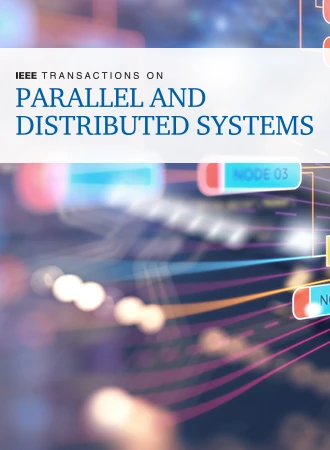Design and Performance Evaluation of Linearly Extensible Cube-Triangle Network for Multicore Systems
IF 5.6
2区 计算机科学
Q1 COMPUTER SCIENCE, THEORY & METHODS
IEEE Transactions on Parallel and Distributed Systems
Pub Date : 2024-10-24
DOI:10.1109/TPDS.2024.3486219
引用次数: 0
Abstract
High-performance interconnection networks are currently being used to design Massively Parallel Computers. Selecting the set of nodes on which parallel tasks execute plays a vital role in the performance of such systems. These networks when deployed to run large parallel applications suffer from communication latencies which ultimately affect the system throughput. Mesh and Torus are primary examples of topologies used in such systems. However, these are being replaced with more efficient and complicated hybrid topologies such as ZMesh and x-Folded TM networks. This paper presents a new topology named as Linearly Extensible Cube-Triangle (LECΔ) which focuses on low latency, lesser average distance and improved throughput. It is symmetrical in nature and exhibits the desirable properties of similar networks with lesser complexity and cost. For N x N network, the LECΔ topology has lesser network latency than that of Mesh, ZMesh, Torus and x-Folded networks. The proposed LECΔ network produces reduced average distance, diameter and cost. It has a high value of bisection width and good scalability. The simulation results show that the performance of LECΔ network is similar to that of Mesh, ZMesh, Torus and x-Folded networks. The results verify the efficiency of the LECΔ network as evaluated and compared with similar networks.多核系统线性可扩展立方三角网络的设计与性能评估
高性能互连网络目前正被用于设计大规模并行计算机。选择执行并行任务的节点集对此类系统的性能起着至关重要的作用。这些网络在部署用于运行大型并行应用时会出现通信延迟,最终影响系统吞吐量。网格和 Torus 是此类系统中使用的拓扑结构的主要例子。然而,这些拓扑结构正在被 ZMesh 和 x-Folded TM 网络等更高效、更复杂的混合拓扑结构所取代。本文提出了一种名为线性可扩展立方体-三角形(LECΔ)的新拓扑结构,其重点是低延迟、减少平均距离和提高吞吐量。它在本质上是对称的,具有类似网络的理想特性,但复杂性和成本较低。对于 N x N 网络,LECΔ 拓扑的网络延迟低于 Mesh、ZMesh、Torus 和 x-Folded 网络。拟议的 LECΔ 网络可减少平均距离、直径和成本。它具有较高的分段宽度值和良好的可扩展性。仿真结果表明,LECΔ 网络的性能与 Mesh、ZMesh、Torus 和 x-Folded 网络相似。这些结果验证了 LECΔ 网络的效率,并将其与类似网络进行了评估和比较。
本文章由计算机程序翻译,如有差异,请以英文原文为准。
求助全文
约1分钟内获得全文
求助全文
来源期刊

IEEE Transactions on Parallel and Distributed Systems
工程技术-工程:电子与电气
CiteScore
11.00
自引率
9.40%
发文量
281
审稿时长
5.6 months
期刊介绍:
IEEE Transactions on Parallel and Distributed Systems (TPDS) is published monthly. It publishes a range of papers, comments on previously published papers, and survey articles that deal with the parallel and distributed systems research areas of current importance to our readers. Particular areas of interest include, but are not limited to:
a) Parallel and distributed algorithms, focusing on topics such as: models of computation; numerical, combinatorial, and data-intensive parallel algorithms, scalability of algorithms and data structures for parallel and distributed systems, communication and synchronization protocols, network algorithms, scheduling, and load balancing.
b) Applications of parallel and distributed computing, including computational and data-enabled science and engineering, big data applications, parallel crowd sourcing, large-scale social network analysis, management of big data, cloud and grid computing, scientific and biomedical applications, mobile computing, and cyber-physical systems.
c) Parallel and distributed architectures, including architectures for instruction-level and thread-level parallelism; design, analysis, implementation, fault resilience and performance measurements of multiple-processor systems; multicore processors, heterogeneous many-core systems; petascale and exascale systems designs; novel big data architectures; special purpose architectures, including graphics processors, signal processors, network processors, media accelerators, and other special purpose processors and accelerators; impact of technology on architecture; network and interconnect architectures; parallel I/O and storage systems; architecture of the memory hierarchy; power-efficient and green computing architectures; dependable architectures; and performance modeling and evaluation.
d) Parallel and distributed software, including parallel and multicore programming languages and compilers, runtime systems, operating systems, Internet computing and web services, resource management including green computing, middleware for grids, clouds, and data centers, libraries, performance modeling and evaluation, parallel programming paradigms, and programming environments and tools.
 求助内容:
求助内容: 应助结果提醒方式:
应助结果提醒方式:


